Since it's summer, why not keep yourself busy with environment friendly and fun learning craft activities that will improve your green way of living. It's pretty usual that after school days, you'll find a lot of projects, research papers, things and stuffs from school piling up in your room. Instead of dumping it all into the bins or wait for the garbage truck to pick them up, why not make use of all those materials for recycling purposes, that sounds much better. To ensure that our own waste wouldn't end up in the landfills, move and start digging inside the box, check all those things you have and see which can still be reused. Aside from those stuffs, recall those paper works and printouts you've made during the school year, set aside the paper materials we'll have a different thing to do with those. What you should be gathering are the printer consumables you spent for all those term papers, researches and printed materials. Here are some of the nicest and niftiest recycling activities that you can do with old and used printer cartridges. Let's bring out the creativity within you, and show your friends how artistically you can be. Starting from the very easy and simple yet fancy project, let's call it as Project1 or the Cartridge Paperweights. Everyone can use it especially in the office, make as many as you can and give it to your mom, dad, brothers, sisters, friends, or anyone that may need it. With the use of some adhesives and glittering accessories, you can embellish the empty cartridges with anything you want. But before doing the fun part, first you have to get dirty cause you need to clean the cartridges and fill it with sand. You can't call it a paperweight if it literally doesn't have any weight,right? Once done decorating the cartridge, glue it into a cardboard or a small piece of wood to serve as its base so it can stand. You now have your very own paperweight out of recycled toner cartridges and ink cartridges. Rank two on our list of the easiest recycling project are the ref-magnets. Instead of buying why not make your own, so you'll have a more customized design and decorations. With Project2, you have to purchase small magnets which will be placed at the back of the cartridges. You can either paint or let the cartridges as it is, but make sure their clean,since kids might reach out of those and nibble it. Third on our list is called the Family Picture Frame. This one's a bit tricky, since you have to collect ink tanks of different sizes and thickness. You'll have a problem if you only have one class of cartridge at home, but I've got a work-around. Get some glue and stick two cartridges to make its width double than the usual, then repeat the process but now make it three pieces of cartridges. Once the glue completely dried out, arrange the cartridges in a cardboard with a size enough to hold your prepared cartridges. Paste those cartridges into the cardboard but don't glue the cartridges near to any cartridge with same thickness. Let the cartridges stick in place, once they're perfectly glued to the board, cut pictures of the members of the family and paste it randomly to the cartridges, then allow it to dry. Here's the hardest and perhaps will keep your hands at work literally. Prepare cartridges of the same sizes and types, clean and remove the labels so it'll have the translucent effect. Now get a wire and make a hole at the bottom side of each cartridges -- from these holes you'll shoot the wire. It's like creating a bracelet of used cartridges, think of the cartridges as the beads and the wire as the string. If you want a lamp with height, glue two layers of it to make a tall lamp. It can also work as a chandelier, just tie a wire on to the top cartridges or the lid and hand it on a chain that can support its weight.
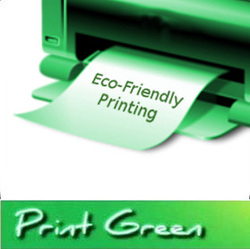 Printing industry is continuously working on developing methods and solutions to replace the production and manufacturing processes involved in issues that affects the environment.Long before they started doing this, the print industry was facing several complains regarding the negative ecological impacts that it produces. The machines itself are not efficient enough to provide environment friendly results. Printer users as well are unconsciously generating waste which are more often ending up as land fillers or mostly in incinerators. But these stories happened long ago, although such problems still exist today, we can say that they're somehow limited and controlled. Reducing landfill waste, this is one of the industry's main goal. Clearly and absolutely, they're giving much effort to improved and push their goal from which they expect to see far better results. Green certifications were given important bearing compared before, even manufacturers are competing to be certified by a number of industry leading organizations that are internationally recognize. Several recycling programs were also implemented and conducted in different parts of the world to promote sustainability by recycling printer supplies. Through establishing recycling programs, manufacturers and consumers work together to reduce landfill waste. If you're not familiar of such recycling programs available for your printer's brand, see this post about HP Planet Partners, especially to those who are using HP printers. Eco-friendly inks and eco-friendly toner cartridges were also developed in the course of achieving environmentally responsible printing solutions. Bio-based inks were introduced and are supposed to replace chemical-based inks with Volatile Organic Compounds (VOC), however, these inks were not ideal nor efficient enough to use for conventional printing. Besides, brand manufacturers might not accept switching the ink formulas from which the customers had been accustomed for several years. Paperless printing or communicating without the need to print was also push and promoted, This in return help save trees from being cut down, reduced environmental impact, plus the amount of paper waste we accumulate dramatically decreased over the past years. Cloud computing services also brought a lot of changes in the industry, not only the technological field of storage space. More probably we can't completely eliminate the need to use paper, but for every paperless action we made, we're moving towards one direction and that is way to a more environment friendly world.
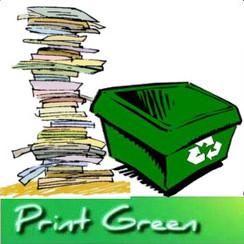 Million tons of paper waste are accumulated annually in the U.S. alone, then what more if we add up the waste from other countries around the world. No one should say that they have no idea on how should they properly managed waste or limit their consumption to reduce their generated waste. Cause as far as today's level of media and technology, we are well informed about such ways and acts that may help us improve our daily living in terms of reducing waste. Saving paper products and materials is not a very hard task, even kids can do it while having fun, it's just a matter of how you imply its worth. Positive results are driven by positive actions, and remember this part of song by the iconic Michael Jackson, "if you wanna make the world a better place, take a look at yourself and make a change". Start doing small things, like changing the way you usually print, it's not easy to change what you've been accustomed to especially if you make it a habit, but still you have to change if it's for the best. Before hitting the print button and sending your file to the print queue, check your file, are there more spaces where you can fit in more into the page, or see if the formatting is efficient both to the printer and paper you'll use. Unless it's a report that requires double spacing or any specific format. See if you can still reduce the font-size to a smaller font, as long as it's still readable, also avoid overly large font sizes and styles, this way you'll not only conserve paper sheets, but the inks/toners as well. Also, it's a good practice to use recycled printer papers and eco-friendly toner cartridges or ink cartridges when printing. The way to communicate with one another has rapidly change, although snail mails are still available. If you're message is not that important, then use a mobile phone, if you want to chat and open a messenger, if it's a bit important or private,then send it through email. Several options are available depending on the importance of what you're about to send. As much as you can eliminate printing emails, bills and all sorts of printables, then do so. Learn to recycle, and if you're not capable of doing such thing which I hardly doubt, then consider participating to any recycling organization in your community that accepts paper materials. To save more paper, we have to use them repeatedly and believe it or not there are hundreds of ways to reuse paper materials which you haven't thought of as possible. Just try to see this post about recycled paper materials turn back into wood or maybe the brief history and facts about paper will guide you on determining how can you make use of paper products efficiently.
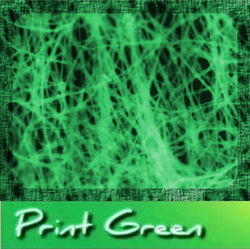 How broad is your knowledge about paper? Do you even know that its name was derive in two different words which is papyrus and papuros? If both of your answers are no, then spend a minute of your time reading this post regarding the things you might want to know about papers. First of all, the term papyrus is a Latin word, derived from the Greek word papuros, is a paper-like material which was first used in Egypt and Southern Sudan. It was extracted from a plant called Cyperus Papyrus in Nile delta. Back in millions of years ago, BCE, the Egyptians were able to utilize it as a writing material where ancient archaeological inscriptions were inscribed in hieroglyphic forms. It was the only material they had that time for writing purposes, however, it was too fragile and more prone to damage due to moisture and dryness, even the texture of it was somewhat irregular for legible writing. Then here comes the innovation, during the early 2nd Century AD, Cai Lun or Ts'ai Lun developed the pulp paper-making process. They cooked wooden fibres and mixed it with a slurry, then poured onto a cloth screen. China used paper as a substitute for silk, hence they were able to export silk instead. Since then, paper spread from China through the Middle East, then by the 13th century it hit the Medieval Europe where the very first paper-mills were built and powered by hydro-electricity. Several improvements and developments run in the history of paper making. One of which is the wood-fiber-pulping method which was developed in 1844 by two Canadian inventors namely Charles Fenerty and German F.G. The pulp paper-making method has two different methods : - Chemical Pulping - which consists of Kraft Process, Sulfite Process and Soda Process.
- Mechanical Pulping - which has two major process, the Thermo Mechanical Process and Groundwood Process.
Aside from the aforementioned methods, have you heard of the the process called " Deinking" or Deinked Pulping? It is simply one of the familiar terms we heard when it comes to preserving paper materials, which is Paper Recycling. Based from the name itself, "de" is a prefix which means to separate or remove, hence Deinking is simply removing the ink from the paper pulps.Generally speaking, recycled paper materials are either of the same quality as a new one, or may offer a bit lower than a manufactured paper out of new wood pulps. However, it's not actually a big deal to consider, especially if you're aiming to reduce paper waste and conserve natural resources particularly the trees. Besides, recycled papers nowadays are mostly compatible for printing purposes as well, just like using eco-friendly toner cartridges and ink cartridges.
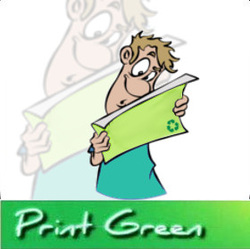 To set the record straight about what's the real deal between the print industry and the environment, how printing affects the ecological system, as well as the environmental impacts of every print we made. Here are the revealing facts that we should know before you skeptically accuse the value of printing. Many companies, not only the manufacturers in the Print Industry, are relying on printing technology. Indeed, there are negative impacts that had brought the environment to a not so well state due to improper printing practices, but it shouldn't always be the one to blame. Let's start with one of it's commonly consumed material, which is paper. People have this common notion that using paper materials kill trees, I give it a check, but trees are renewable, thus it can be replaced. For a fact, in the United States alone, they managed to increase their trees population by up to 20% in comparison to the 1st Earth Day celebration way back 40 years ago ( AF&PA). Private land owners in U.S. are planting trees everyday, 4 times the number of trees they harvest daily, and still continue to keep their land for forestry. The bottom line here is that, if you keep on wasting or using paper products, then might as well double or triple your effort on giving back what you got, plant trees more than what you consumed. E-Books are very common nowadays which perhaps affects the industry of book publishing. Books are produced from paper materials and printing process, and if you think you're helping the environment by becoming an E-Reader, here's what you need to know. Paper productions require about 50-60% of energy which comes from renewable resources, take note of the word "renewable". Now with those E-Books, how are you supposed to access and read those? Through tablets, smartphones, mobile devices, etc., whatever you call it, still they all generally address as electronic wastes. Another question, how are you supposed to use an e-book reader unless it has a charge right? Do you think the power or energy that your devices consumed can be renewed, even so, the health effects and environmental effects of using such devices are more adverse than reading a book. Electronic waste or what you call high-end devices, are made of plastics, metals, and a combination of minerals that are non-renewable, and can only be acquired through mining. Furthermore, most of these devices have only 60-80% of their components which can be recycled, the rest are dismantled, disposed and end up as land fillers. Whereas the supplies and consumables of a printer has a better rate of recyclability. Printer cartridges for example can be recycled for more than 4-5 times or more, these are called recycled toner cartridges and ink cartridges. They produce less carbon footprint compared to several electronic devices that unsafely and uncontrollably emitting carbon footprints which definitely harm the environment.
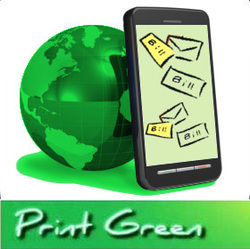 To print or not to print? It's not a slogan nor a motto, it's a question you should be asking to yourself every time you're about to make a print. Do you really need a copy of this, or is it that important that you really need a printed copy? Unless it's a business related document or file, say a report, of course you'll be needing a printer, but actually you can just save it to a storage device, bring it in the office and distribute it to everyone who will be coming to the meeting. However, not all companies or offices would suggest this idea as they would still prefer having a hard copy. But ideally, the one we suggested would be more convenient and efficient for a company and even to all its employees. Bills and receipts likewise, can be access online through your account, instead of receiving monthly sheets of bills, why not consider paperless billing? A few stores in the U.S. are offering electronic receipts, which aids in the reduction of paper wastes. Besides, it would be nice to have a digital receipt if there are chances that you want to return a certain product. If you're a coupon and discount fanatic, there are downloadable apps that you can get for free to save and view those coupons you gained. Instead of printing discount stubs and coupons, these applications will allow the user to view the coupon through their mobile devices, plus they keep you updated with the latest promo and offers from various brands and stores. Make use of your handsets or tablets when making schedules and setting appointments. Digital memo is more ideal and efficient that arranging your schedule on a PC or laptop, print it and keep inside your bag, wallet or organizer. An organizer will do, but what we're trying to achieve is a paperless environment right, thus using sticky notes, memo pads, and organizers is a big no no. In the event that you really need to print a certain document, file or whatever it is, make sure you have enough supplies of environment friendly products such as recycled paper or much better if you're using recycled toner cartridges and ink cartridges. Through these suggestions, you get to save your hard-earned money, and greatly help in saving our environment by doing all means and possibilities to reduce your own waste especially with your daily printing. There are several ways and options to utilize a mobile device which will improve one's perspective and dedication to green living. Additionally, our today's technology is partly adjusting to at least diminish the negative impacts that many industries are generating. If you have a great idea to contribute, please let me know in the comments below.
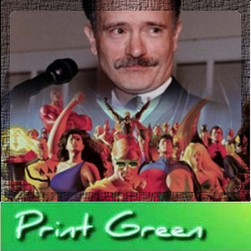 Here's a very interesting fact that should be shared to everyone. Upon browsing the web I happened to stumble from a geek trivia asking "which comic book artist's ashes were mixed into ink then used to print comics?". I find in intriguing and honestly I wasn't able to answer it right, of course I have no idea who that man could be, and so I research about this honorable guy. His name was Mark Gruenwald, a well known comic artist at Marvel comics. He started publishing his own fanzine in 1970, and was hired as an assistant editor on that same year. He's one of the creative artists of these famous comic books like Captain America, The Avengers, Thor, Spiderman and Ironman. Also, his pencil works were part of the The Incredible Hulk which is still a known story to kids until now. From being an assistant editor, he was then promoted as a senior editor after all his hard works, and he would oversee a few of the legendary stories that Marvel comics produced. He died with a congenital heart defect in 1996 from where his career also ended. But before Gruenwald died, he insisted to be cremated and requested to let his ash remains mixed with the ink that will be used to print comics. His wish was granted and in 1997, about the early season of summer, Marvel Comics printed graphic novel copy of the late Gruenwald's very own mini-series which is the Squadron Supreme. It was printed in Canton, Ohio printing facility using the ink from which the artist's ashes had been blended with. It was such a naive wish from a great comic book artist to let his remains be blended with the masterpiece which was once he was doing when he's still alive. He became literally a part of the limited graphic novel copy of his own story and lives eternally with such honor. Mark Gruenwald had leaved a mark in the history of comic book industry not only with his tremendously awesome works, but also with his real life story. We can also make our own history in simple ways. You see, Gruenwald loves his career and was also loved by many, and with his passion towards his job, he made an incredible yet honorable decision to contribute himself, not only his talent but his whole being in the industry where he lived. With this in mind and the current situation between the print industry and our environment, have you asked yourself what things could you possibly do to neutralize the problem? There are several options for us to consider, but it takes dedication and passion with the effort to aid in the sustainability. We can't just blend ourselves with the ink we used on our daily printing just like what he did, however, we can opt for what's more ideal and efficient alternatives such as eco-friendly toner cartridges and ink cartridges. Switch to green printing now, and become a part of the mark that it will leave in our history.
Almost one week from now, the International Society for Technology in Education (ISTE) Conference will take place at the Henry B. Gonzalez Convention Center in San Antonio, Texas this June 23 until 26. This annual conference aims to provide useful and worthy technology intuitiveness through hundreds of sessions and learning environments which includes the participation of OKI Data Americas to demonstrate their company's newest printer equipment for education solutions. There will be several companies expected to present educational information, services and products. One of the events essential purposes is to let the attendees particularly teachers or educators to engage and learn from this conference, then eventually integrate into curricula what they acquired. In their booth specifically for OKI #6287, the company will be demonstrating modern printer products and solutions which include the following: - C831 - a tabloid/A3 color printer that combines a powerful feature set with fast print speeds and banner printing capabilities in a compact device that is ideal for demanding small workgroups.
- MC562w - a small workgroup color MFP that offers large paper capacity, fast print speeds, duplex printing and copying, wireless capability, and high definition color technology.
- C711WT - a desktop A4 digital color printer featuring white toner in a CMYW four-color configuration that delivers sharp, white output that brings high-quality printing capabilities in-house.
- MC770 - a mid-workgroup A4 color MFP that combines high-speed output, high print quality, enhanced feature sets, and OKI's smart Extendable Platform that supports an expanding suite of OKI solutions and meets demands of busy work environments.
- Remark Test Grading Solution - a streamlined and efficient test grading solution that can scan, process, score bubble chart tests and run reports with ease.
- PaperCut MF - a print job accounting and management software solution that can work with both single function and multifunction printers with OKI's smart Extendable Platform. The software helps organizations save money on excess and unauthorized printing by creating a secure and confidential printing environment.
- School Communications Pack - a DVD filled with more than 100 pre-designed teaching tools and templates for educators to be used with the banner printing capabilities of OKI's HD digital color printers.
- OKI MotionPrint - a solution that allows users to print documents from compatible mobile devices to specific OKI printers and MFPs.
Among the aforementioned products, our up-votes will probably be for the PaperCut MF software, since it aids on preventing excessive and unnecessary printing which leads to waste. Additionally, it's a very cost-efficient solution for schools that would like to save more money from school supplies and equipment or perhaps reduce the expenses. It's also a bright idea to educate their students about green printing practices and the ecological impacts of the print industry on our environment. If it's possible for us to teach them and let kids take in the significance of responsible printing, then let's take all the opportunities. Furthermore, introducing them to some recycled school supplies and products that might be useful for schooling is an excellent idea. Products such as recycled notebooks, pens, paper materials, and also those eco-friendly toner cartridges and ink cartridges for their school's new printer if in case they're planning to avail any of the OKI printers that will be featured in the conference.
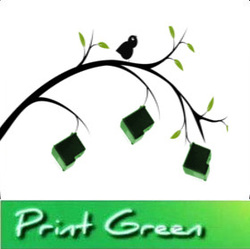 When it comes to printing one must be ready with the expected and unexpected expenses that may arise along with maintaining a printer. At first you might not be able to notice this but actually purchasing such device will not count as the beginning, but rather by the time you have to get a replacement once the initial supplies run empty. A customer who owns a printer for such a long time is practically aware of how expensive print consumables can be. In fact, they said that if try to pile or sum up all the receipts and cost you spent over a year from buying cartridges, you might just drop your jaw. That's where the idea came from, that -- you would rather get a new printer that comes with a set of free cartridges instead of purchasing a set of replacements. One of the simplest and ideal way to considerably make the expense lower is to start using recycled printer supplies. These products are definitely not associated to those substandard consumables. Compatible cartridges are also different from recycled supplies, nor it's not even related to refilled cartridges, not at all. Recycled printer cartridges are made from used or empty ink and toner consumables which are basically reused to manufacture new original supplies. Once a cartridge runs empty on ink or toner, it's just the consumable inside it that was spent. While the components are still reusable and in good working conditions, manufacturers along with their recycling programs accept returned supplies such as cartridges and even old printers. Some organizations would be more glad to give rewards to anyone who participate in their programs by simply returning their printer's spent cartridges or again even the machine itself once it reaches it's end-of-life. Post-consumer cartridges are not the only ones that undergo recycling process, paper products particularly the supplies we used for printing purposes can also be recycled. Whether you're using a printer in the office or at home, wouldn't it be more convenient in your part if your device is using cost-efficient and environment friendly recycled toner cartridges or ink cartridges, plus those recycled paper materials?Again, it's not hard to switch to green printing practices and it wouldn't break the bank or cost you more, than keep on using highly expensive replacements. The market has a lot to offer, but remember although there's an abundant of supplies to choose from, cheaper doesn't always mean ideal and you have to learn how to dig inside a mixed bag. It's either you fall into the right retailer or end up wasting your money from fraud manufacturers.
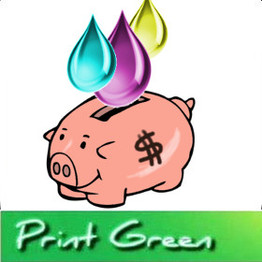 Printing, especially in any office or working environment, is a daily task that not only create printouts but it also generate waste and mounting expenses. But do you know what are the things or possible ways that you can apply whenever printing, in order to reduce or probably get rid of such problems with your printer? Also, are you aware of your machines extra economical features that might help you cut down the expenses and negative environmental impacts that come along with using electronic devices? Limiting the number of times you print per day is possible, however it's not always applicable in a daily basis, considering that there are unexpected reports and paper works you might encounter at any time. Though this might not be a good suggestion for photography enthusiast since it's actually a different issue. Being green is one of the best things you can do for free with all the decision depending on your own will. Hence adapting these helpful ideas and techniques can help you save time and money particularly in printing. As a standard font-size, 12 is obviously the one we often use, provided that texts are more easy to read at this size. But a file with lengthy of text will tend to consume more inks and paper materials, thus scaling down the font-size to 11 or at least to 10 is almost considerable. Such fonts are still readable, plus you not only consumed less inks/toners but paper sheets as well.From font-size we go to font-style. Are you aware of those fonts that eat up unnecessary amount of inks? It's not that you shouldn't use them at all, but as much as you can avoid those, then it would be better. Unless you really want some curls and tails in each letters of your document, but don't complain if you frequently replenish your machine's consumables. Suggested font-styles to use are : Arial, Courier, Times New Roman and Garamond, these are just some of the considered economical fonts that help save inks.Econo-mode or grayscale printing is a feature that not all printers support.If you use it by default with your printer, the useful life of the cartridges installed in it might be stretched. If your printer has this feature you can enable it through this steps: - On the File menu in the software program, click Print .
- Select the appropriate product, and then click Properties or Preferences .
- On the Paper/Quality tab, select FastRes1200 or 600dpi .
- Select the EconoMode check box.
- Click OK .
Additionally, you can opt for remanufactured toner cartridges and ink cartridges to significantly reduce the overall operating cost of your printer. Plus, the environment will definitely give a thumbs up for switching to eco-friendly supplies.
|








 RSS Feed
RSS Feed